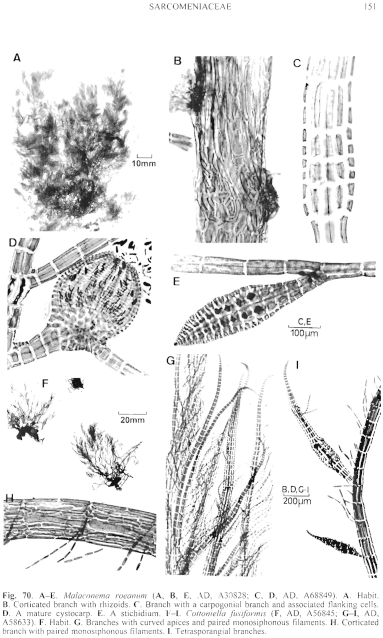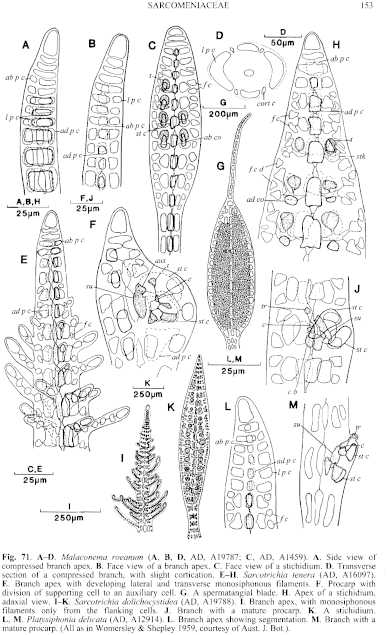|
|
|
|
|
|||||||||||
|
Electronic Flora of South Australia Species Fact Sheet
Phylum Rhodophyta – Family Sarcomeniaceae
Selected citations: May 1965: 378. Silva et al. 1996: 526. Womersley 1966: 153. Wynne 1996: 180.
Synonyms
Polysiphonia roeana Harvey 1855a: 540; 1858: pl. 35; 1863, synop.: xx. J. Agardh 1863: 967; De Toni 1903: 877. Kützing 1864: 20, pl. 55a-c. Lucas 1909: 40. Lucas & Perrin 1947: 267. Segi 1966: 512, pl. XXIIG. Sonder 1880: 34. Womersley & Shepley 1959: 204, figs 106–110, pl. 5 fig. 1.
Vertebrata roeana (Harvey) Kuntze 1891: 929.
Thallus (Fig. 70A) medium to dark red-brown, often with a greyish iridescence, becoming rose-red to grey-red and decomposing rapidly, erect, 5–20 cm high, much branched with slender branches distinctly but slightly laterally compressed (Fig. 71D) and without flanking cells in vegetative parts; axes 200–500 (–900) µm broad, tapering to 30–40 µm broad near the apices. Attachment by rhizoids with multicellular haptera, arising from cortical cells; epiphytic, possibly epilithic. Structure. Apical cell (Fig. 71A–C) hemispherical with axial cells cutting off 4 pericentral cells in alternating sequence, with slightly larger lateral pericentral cells; flanking cells absent in vegetative branches. Segments L/D 1–1.5 above, increasing to L/D 1.5–3 below; slight cortication (Fig. 70B) by longitudinal rows of small elongate cells occurs, but no monosiphonous filaments occur. Branching endogenous, largely adaxial. Cells uninucleate, larger cells multinucleate; rhodoplasts discoid, chained in larger cells.
Reproduction: Carpogonial branches borne on the adaxial transverse pericentral cell, with the lateral pericentral cells of several adjacent segments bearing flanking cells (Fig. 70C). Carposporophytes with an elongate basal fusion cell and much branched gonimoblast with clavate terminal carposporangia 30–40 µm in diameter. Cystocarps (Fig. 70D) sessile, ovoid; pericarp ostiolate, 2 cells thick, ecorticate, outer cells transversely elongate. Spermatangia unknown.
Tetrasporangial stichidia (Figs 70E, 71C) apparently rare, formed from ends of lateral branches with the upper 8–12 segments bearing tetrasporangia. Typical flanking cells develop on fertile segments, remaining undivided, with tetrasporangia in 2 longitudinal rows cut off from the lateral pericentral cells. Adaxial and abaxial cover cells partly protect the tetrasporangia, with the flanking cells becoming elongate and curved; tetrasporangia 40–70 µm in diameter.
Type from Fremantle, W. Aust. (Harvey); lectotype Harvey Alg. Aust. Exsicc, 169A in TCD.
Selected specimens: Torrens Strait (Torrens I.), Outer Harbor, S. Aust. (Dec. 1887; AD, A1459). American R. inlet, Kangaroo I., S. Aust., drift (Shepley, 18.viii.1954; AD, A19787-"Marine Algae of southern Australia" No. 119) and (Womersley, 25.viii.1963; AD, A26727 and 31.x.1966; AD, A30828). Near Muston, American R. inlet, Kangaroo I., S. Aust., on Posidonia australis, 2–3 m deep (Kraft, 17.vii.1972; AD, A42526). Ironstone Point, Penneshaw, Kangaroo I., S. Aust., on Glossophora, 15 m deep (Lavers, 29.ii.2000; AD, A68849). St Leonards, Port Phillip, Vic., on Heterozostera, 1–3 m deep (Womersley, 9.viii.1959; AD, A23084). Port Arlington, Port Phillip, Vic., 0–2 m deep (Womersley, 9.viii.1959; AD, A23118).
Distribution: Only known from the type and from Torrens "Strait"(Outer Harbor) and American R. inlet and Penneshaw, Kangaroo I., S. Aust., and Port Phillip, Victoria.
Taxonomic notes: Al. roeana is characterised by its habit, rapid disintegration, thallus structure and presence of flanking cells only in fertile segments. It occurs in calm water situations.
References:
AGARDH, J.G. (1863). Species Genera et Ordines Algarum. Vol. 2, Part 3, pp. 787–1291. (Gleerup: Lund.)
HARVEY, W.H. (1855a). Some account of the marine botany of the colony of Western Australia. Trans. R. Jr. Acad. 22, 525–566.
HARVEY, W.H. (1858). Phycologia Australica. Vol. 1, Plates 1–60. (Reeve: London.)
HARVEY, W.H. (1863). Phycologia Australica. Vol. 5, Plates 241–300, synop., pp. i-lxxiii. (Reeve: London.)
KÜTZING, F.T. (1864). Tabulae Phycologicae. Vol. 14. (Nordhausen.)
KUNTZE, O. (1891). Revisio generum Plantarum. Part II. 4. Algae, pp. 877–930. (Leipzig.)
LUCAS, A.H.S. & PERRIN, F. (1947). The Seaweeds of South Australia. Part 2. The Red Seaweeds. (Govt Printer: Adelaide.)
LUCAS, A.H.S. (1909). Revised list of the Fucoideae and Florideae of Australia. Proc. Linn. Soc. N.S.W. 34, 9–60.
MAY, V. (1965). A census and key to the species of Rhodophyceae (red algae) recorded from Australia. Contr. N.S. W. Natl Herb. 3, 349–429.
SEGI, T. (1966). The type or authentic specimens of Polysiphonia in Europe. Rep. Fac. Fish., Prefect. Univ. Mie 5, 503–516, Plates 1–25.
SILVA, P.C., BASSON, P.W. & MOE, R.L. (1996). Catalogue of the Benthic Marine Algae of the Indian Ocean. (Univ. California Press: Berkeley.)
SONDER, O.W. (1880). In Mueller, F., Fragmenta Phytographiae Australiae. Supplementum ad volumen undecinum: Algae Australianae hactenus cognitae, pp. 1–42, 105–107. (Melbourne.)
WOMERSLEY, H.B.S. & SHEPLEY, E.A. (1959). Studies on the Sarcomenia group of the Rhodophyta. Aust. J. Bot. 7, 168–223.
WOMERSLEY, H.B.S. (1966). Port Phillip survey, 1957–1963: Algae. Mem. natl. Mus., Vict. No. 27, 133–156.
WYNNE, M.J. (1996). A revised key to genera of the red algal family Delesseriaceae. Nova Hedwigia 112, 171–190.
The Marine Benthic Flora of Southern Australia Part IIID complete list of references.
Publication:
Womersley, H.B.S. (24 February, 2003)
The Marine Benthic Flora of Southern Australia
Rhodophyta. Part IIID. Ceramiales – Delesseriaceae, Sarcomeniaceae, Rhodomelaceae
Reproduced with permission from The Marine Benthic Flora of Southern Australia Part IIID 2003, by H.B.S. Womersley. Australian Biological Resources Study, Canberra. Copyright Commonwealth of Australia.
Illustrations in Womersley Part IIIA, 2003: FIGS 70 A–E, 71 A–D.

Figure 70 enlarge
Fig. 70. A–E. Malaconema roeanum (A, B, E, AD, A30828; C, D, AD, A68849). A. Habit. B. Corticated branch with rhizoids. C. Branch with a carpogonial branch and associated flanking cells. D. A mature cystocarp. E. A stichidium. F–I. Cottoniella fusiformis (F, AD, A56845; G–I, AD, A58633). F. Habit. G. Branches with curved apices and paired monosiphonous filaments. H. Corticated branch with paired monosiphonous filaments. I. Tetrasporangial branches.

Figure 71 enlarge
Fig. 71. A–D. Malaconema roeanum (A, B, D, AD, A19787; C, AD, A1459). A. Side view of compressed branch apex. B. Face view of a branch apex. C. Face view of a stichidium. D. Transverse section of a compressed branch, with slight cortication. E–H. Sarcotrichia tenera (AD, A16097). E. Branch apex with developing lateral and transverse monosiphonous filaments. F. Procarp with division of supporting cell to an auxiliary cell. C. A spermatangial blade. H. Apex of a stichidium, adaxial view. I–K. Sarcotrichia dolichocystidea (AD, A19788). 1. Branch apex, with monosiphonous filaments only from the flanking cells. J. Branch with a mature procarp. K. A stichidium. L, M. Platysiphonia delicata (AD, Al2914). L. Branch apex showing segmentation. M. Branch with a mature procarp. (All as in Womersley & Shepley 1959, courtesy of Aust. J. Bot.).

|
Email Contact: State Herbarium of South Australia |

|